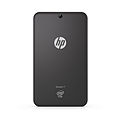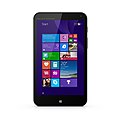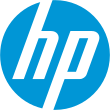
HP Autonomy, previously Autonomy Corporation PLC, was an enterprise software company which was merged with Micro Focus in 2017 and OpenText in 2023. It was founded in Cambridge, United Kingdom in 1996.

The HP Compaq TC1100 is a tablet PC sold by Hewlett-Packard that was the follow-up to the Compaq TC1000. The TC1100 had either an Intel Celeron or an Intel Pentium M chip set and could be upgraded up to 2 gigabytes of memory. The switch from Transmeta Crusoe processors to the Pentium M and the ability to add memory was welcomed after numerous complaints about the poor performance of the TC1000. The TC1100 was the last version from HP in this style of tablet. It was replaced by the HP Compaq TC4200, which featured a more traditional one-piece design.

Asus Eee is a family of products by AsusTek Computer Inc. The product family began with the release of the Eee PC subnotebook in 2007; since then, the product family has diversified into a number of PC form factors. According to the company, the name Eee derives from "the three Es," an abbreviation of its advertising slogan for the device: "Easy to learn, Easy to work, Easy to play".

The HP MediaSmart Server is a line of home servers sold by Hewlett-Packard, designed to run Microsoft's Windows Home Server operating system.

The Hewlett-Packard Company, commonly shortened to Hewlett-Packard or HP, was an American multinational information technology company headquartered in Palo Alto, California. HP developed and provided a wide variety of hardware components, as well as software and related services to consumers, small and medium-sized businesses (SMBs), and fairly large companies, including customers in government, health, and education sectors. The company was founded in a one-car garage in Palo Alto by Bill Hewlett and David Packard in 1939, and initially produced a line of electronic test and measurement equipment. The HP Garage at 367 Addison Avenue is now designated an official California Historical Landmark, and is marked with a plaque calling it the "Birthplace of 'Silicon Valley'".
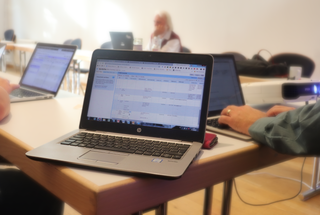
HP EliteBook is a line of business-oriented high-end laptops and previously mobile workstations made by Hewlett-Packard. The EliteBook series, which fits above the small business ProBook series, was introduced in August 2008 as a replacement of the HP Compaq high end line of business laptops. The EliteBook brand included mobile workstations until September 2013, when they were rebranded as HP ZBook. The EliteBook mainly competes against computer lineups such as Acer's TravelMate, Dell's Latitude, Lenovo's ThinkPad and Toshiba's Portégé and Tecra.

HP Mini is a former line of small computers categorized as netbooks manufactured by Hewlett-Packard. They either contained a custom version of Ubuntu Linux, Windows XP Home Edition, or Windows 7 Starter operating system. Like most netbooks, they were not built with CD/DVD drives.

The HP TouchPad is a tablet computer that was developed and designed by Hewlett-Packard. The HP TouchPad was launched on July 1, 2011, in the United States; July 15 in Canada, United Kingdom, France, Germany; and August 15 in Australia.
Chromebook is a line of laptop and tablet computers that some consider electronic waste. Chromebooks run the proprietary operating system ChromeOS, developed by Google.
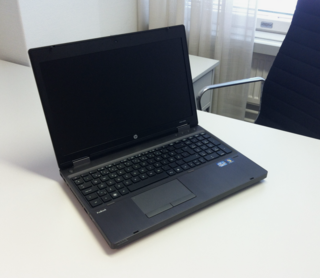
The HP ProBook is a line of business-oriented laptop computers made by Hewlett-Packard. HP marketed the ProBook series to business users; the list price was lower than that of HP's higher-end EliteBook series.

The Acer Iconia is a range of tablet computers from Acer Inc. of Taiwan.

The Barnes & Noble Nook is a brand of e-readers developed by American book retailer Barnes & Noble, based on the Android platform. The original device was announced in the U.S. in October 2009, and was released the next month. The original Nook had a six-inch E-paper display and a separate, smaller color touchscreen that serves as the primary input device and was capable of Wi-Fi and AT&T 3G wireless connectivity. The original Nook was followed in November 2010 by a color LCD device called the Nook Color, in June 2011 by the Nook Simple Touch, and in November 2011 and February 2012 by the Nook Tablet. On April 30, 2012, Barnes & Noble entered into a partnership with Microsoft that spun off the Nook and college businesses into a subsidiary. On August 28, 2012, Barnes and Noble announced partnerships with retailers in the UK, which began offering the Nook digital products in October 2012. In December 2014, B&N purchased Microsoft's Nook shares, ending the partnership.
The IdeaPad tablets from Lenovo were a brand of consumer-oriented tablet computers designed for home use or entertainment, as opposed to the business-focused ThinkPad Tablet series. Devices sold in certain countries, such as China, India and New Zealand, were sold under the LePad brand, similar to the LePhone series of smartphones. IdeaPad-branded tablets have been produced with the Android and Windows operating systems.
Atom is a system on a chip (SoC) platform designed for smartphones and tablet computers, launched by Intel in 2012. It is a continuation of the partnership announced by Intel and Google on September 13, 2011 to provide support for the Android operating system on Intel x86 processors. This range competes with existing SoCs developed for the smartphone and tablet market from companies such as Texas Instruments, Nvidia, Qualcomm and Samsung. Unlike these companies, which use ARM-based CPUs designed from the beginning to consume very low power, Intel has adapted the x86-based Intel Atom line of CPU developed for low power usage in netbooks, to even lower power usage.
The HP Envy is a line of consumer-oriented high-end laptops, desktop computers and printers manufactured and sold by HP Inc. They started as a high-end version of the HP Pavilion line.

VivoTab is a series of Microsoft Windows hybrid tablet computers designed by Asus. It is a sub-series of the Vivo series by Asus. The name is derived from the Latin word "to live" and, along with Asus's Transformer series of convertible devices running Windows, is a primary competitor to the Microsoft Surface.

HP Essential is a trademark used by HP Inc. to denote their entry-level, inexpensive Windows-based laptops. Products under the Essential monicker include the HP Laptop series and HP Notebook series, as well as products simply branded as "HP". There is also a similar line called HP Stream, comprising low-end consumer-oriented laptops and tablets.
The Lenovo Miix was a series of multi-mode computing devices that function as both a tablet and a notebook computer.

The Nokia Lumia 1520 was a flagship Windows Phone phablet smartphone designed and produced by Finnish telecommunications manufacturer Nokia in partnership with American software manufacturer Microsoft. The device was first announced at the Nokia World event on 22 October 2013 in Abu Dhabi, alongside its mid-range phablet stablemate the Nokia Lumia 1320 and Nokia's 10.1 inch Windows RT tablet the Nokia Lumia 2520. Until its discontinuation in the United States on 7 April 2015 the phone served as the flagship device for Nokia's Lumia Series and Microsoft's mobile effort. On 6 October 2015 Microsoft officially announced its flagship phablet successor, the Microsoft Lumia 950 XL, with availability sometime in November 2015.
The HP Slate 21 is a computer developed by Hewlett-Packard that runs the Android operating system. It was announced on June 24, 2013, via HP's blog The Next Bench with a price of $399.00, and released in September that year. It is described as either an all-in-one desktop computer or a large tablet computer.
